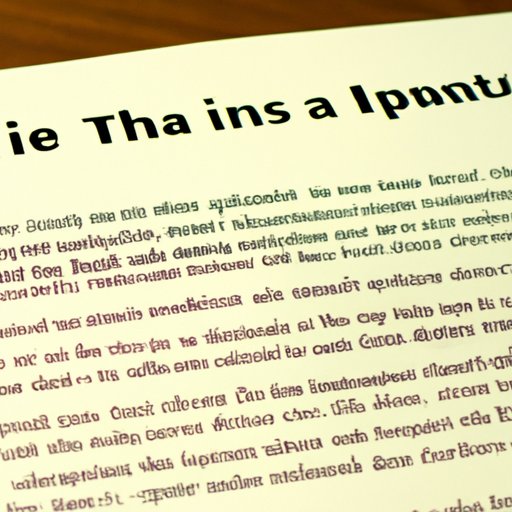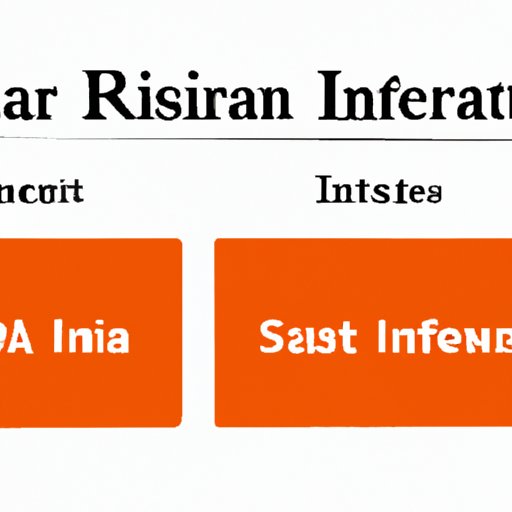Introduction
A traditional IRA (Individual Retirement Account) is a type of retirement savings account that allows individuals to save for retirement on a tax-advantaged basis. With a traditional IRA, you can make tax-deductible contributions, withdraw funds without penalty, and enjoy tax-deferred growth. In this article, we’ll explore the basics of how traditional IRAs work, compare them to other investment options, and explain the differences between traditional and Roth IRAs.

Exploring the Basics of Traditional IRAs: What They Are and How They Work
Traditional IRAs are designed to help individuals save money for retirement. With a traditional IRA, you can contribute up to $6,000 each year (or $7,000 if you’re 50 or older). These contributions are made with pre-tax dollars, meaning they reduce your taxable income for the year. Any earnings on the investments in your IRA are not taxed until you take them out of the account.
When it comes time to withdraw funds from your traditional IRA, you’ll be subject to income taxes on the amount you withdraw. There may also be early withdrawal penalties if you withdraw funds before age 59 ½. However, there are some exceptions to this rule. For example, you may be able to take penalty-free withdrawals for certain medical expenses, educational expenses, or first-time home purchases.
In addition to allowing you to save for retirement on a tax-advantaged basis, traditional IRAs also offer other tax benefits. For example, any earnings on the investments in your IRA are not taxed until you take them out of the account. This allows your investments to grow tax-deferred, which can result in significant savings over time.
A Guide to Traditional IRAs: Understanding Contributions, Withdrawals, and Tax Benefits
When it comes to contributing to a traditional IRA, there are several important rules to keep in mind. First, the maximum contribution limit for 2020 is $6,000 (or $7,000 if you’re 50 or older). Second, you must have earned income in order to make a contribution. Finally, you must be under age 70 ½ in order to make a contribution. If you exceed these limits, you may be subject to taxes and/or penalties.
When it comes to taking withdrawals from a traditional IRA, there are also a few important rules to keep in mind. First, you must be at least age 59 ½ in order to take penalty-free withdrawals. Second, you must begin taking required minimum distributions (RMDs) by April 1st of the year following the year in which you turn 70 ½. Third, you may be subject to taxes on the amount you withdraw. Finally, there are certain exceptions that may allow you to take penalty-free withdrawals for certain medical expenses, educational expenses, or first-time home purchases.
In addition to allowing you to save for retirement on a tax-advantaged basis, traditional IRAs also offer other tax benefits. For example, any earnings on the investments in your IRA are not taxed until you take them out of the account. This allows your investments to grow tax-deferred, which can result in significant savings over time. Additionally, traditional IRAs may offer tax deductions for contributions, depending on your income level and other factors.

Retirement Savings Strategies: Comparing Traditional IRAs with Other Investment Options
When it comes to saving for retirement, there are many different investment options available. Some of these options include 401(k) plans, annuities, mutual funds, and stocks. Each option has its own advantages and disadvantages. It’s important to understand the differences between these options so that you can choose the best one for your needs.
One of the biggest advantages of traditional IRAs is that they offer tax-deferred growth. This means that any earnings on the investments in your IRA are not taxed until you take them out of the account. This can result in significant savings over time. Additionally, traditional IRAs may offer tax deductions for contributions, depending on your income level and other factors.
Another advantage of traditional IRAs is that they are generally easier to manage than other types of investments. Unlike some other retirement savings options, traditional IRAs do not require you to actively manage your investments. This makes them an attractive option for those who are looking for a simple, low-maintenance way to save for retirement.
The Benefits of a Traditional IRA: Maximizing Your Retirement Savings
A traditional IRA can be an excellent way to maximize your retirement savings. The tax-deferred growth offered by traditional IRAs can result in significant savings over time. Additionally, traditional IRAs may offer tax deductions for contributions, depending on your income level and other factors. Furthermore, traditional IRAs are generally easier to manage than other types of investments.
When investing in a traditional IRA, it’s important to remember that you should only invest what you can afford to lose. Investing in the stock market can be risky, and you could lose some or all of your investment. Additionally, you should always consult a financial advisor before making any major investment decisions.
Traditional IRA Rollovers: How to Transfer Funds from an Employer-Sponsored Plan
If you have an employer-sponsored retirement plan, such as a 401(k) or 403(b), you may be able to transfer funds into a traditional IRA. This is known as a rollover. To complete a rollover, you’ll need to meet certain eligibility requirements and follow a few steps. One of the most important steps is to ensure that the funds are transferred directly from the employer-sponsored plan to the traditional IRA.
Once the funds have been transferred, you’ll be able to use them to make tax-deductible contributions to your traditional IRA. It’s important to note that there are tax implications associated with rollovers. Depending on your situation, you may be subject to taxes and/or penalties when you rollover funds from an employer-sponsored plan to a traditional IRA.
Traditional IRAs vs. Roth IRAs: Which is Right for You?
When it comes to retirement savings, there are two main types of IRAs: traditional IRAs and Roth IRAs. While both offer tax-advantaged savings, there are some key differences between the two. Traditional IRAs allow you to make tax-deductible contributions and enjoy tax-deferred growth. On the other hand, Roth IRAs allow you to make after-tax contributions and enjoy tax-free growth.
When deciding which type of IRA is right for you, there are several factors to consider. Traditional IRAs may be a better option for those who expect to be in a lower tax bracket when they retire. On the other hand, Roth IRAs may be a better option for those who expect to be in a higher tax bracket when they retire. Ultimately, the best option for you will depend on your individual financial situation.
Conclusion
A traditional IRA is a great way to save for retirement on a tax-advantaged basis. With a traditional IRA, you can make tax-deductible contributions, withdraw funds without penalty, and enjoy tax-deferred growth. Additionally, traditional IRAs may offer tax deductions for contributions, depending on your income level and other factors. It’s important to understand the basics of how traditional IRAs work, compare them to other investment options, and understand the differences between traditional and Roth IRAs before making any major investment decisions.
(Note: Is this article not meeting your expectations? Do you have knowledge or insights to share? Unlock new opportunities and expand your reach by joining our authors team. Click Registration to join us and share your expertise with our readers.)
